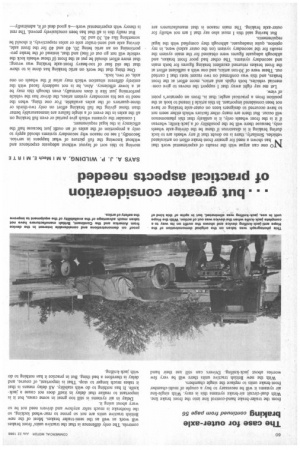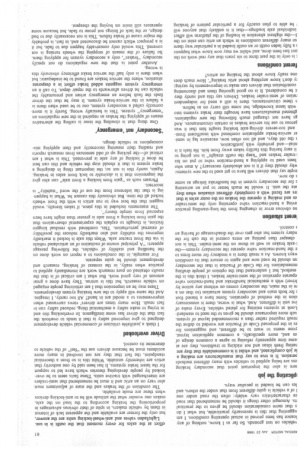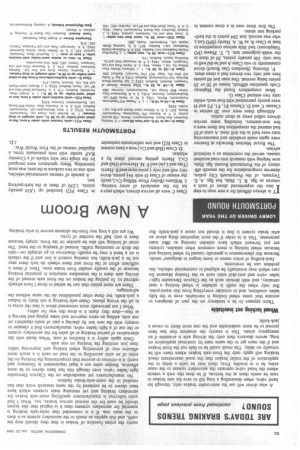. . . but greater consideration of practical aspects needed
Page 62

Page 63

Page 64

If you've noticed an error in this article please click here to report it so we can fix it.
SAYS A. J. P. WILDING, AMIMechE,MIRTE NO one can argue with the results of experimental work that has shown a need for greater front-brake effort on articulated vehicles. Similarly, there is no doubt that if any wheels are to lock during braking it is disastrous if these be the driving-axle wheels only, because there will be the possibility of a jack-knife; whereas if it is the front wheels only, it is unlikely that this phenomenon will occur. But there are many other factors which either seem not to have occurred to designers keen on outer-axle braking or have not been considered important. In this article I intend to look at the position from a practical angle; that is, from an operator's point of view.
Let me say right away that I support the moves to give commercial vehicles, both rigids and allies, more effort at the front brakes, and this was confirmed on two recent tests that I carried out. These were of 30-ton artics, and one with a sufficient effort at the front brakes returned excellent braking figures for both main and secondary systems. The other had poor front brakes, and although adequate figures were obtained for the main system the results for the secondary system (on the outer axles) were, in my opinion, quite inadequate, although they complied with the legal requirements.
But having said this I must also say that I am not wholly for outer-axle braking. The main reason is that manufacturers are moving to this sort of layout without adequate experience and without knowing the full picture of what happens in service. Secondly, I see no reason why secondary systems should apply to only a proportion of the axles of an outfit just because half the efficiency is the legal requirement.
I consider the systems which give partial or even full braking on all the axles in the event of a single failure are immeasurably better than those giving the full braking effort on only two-thirds or three-quarters of the axles available. For one thing, when the need to use his secondary system arises, the driver has the vehicle performing just like it does normally, even though this may be at a lower efficiency. Also, he is not suddenly faced with the entirely different situation which may arise if the wheels on one axle, or two, lock.
One thing that the work on artic braking has done is to show that the old fear of too-heavy front-axle braking was wrong; that more effort should be put at the front (if these wheels lock the vehicle will not go out of line) and that, instead of the brake proportioning on an artic being 20, 40 and 40 for the front axle, driving axle and semi-trailer axle or axles respectively, it should be something like 40, 30 and 30.
But really this is all that has been conclusively proved. The rest is theory with experimental work—a good deal of it, admittedly vehicles on test gronnds. So far as I know, nothing of any icance has been proved in actual operating conditions. I am .uggesting that this is necessarily practicable, but what I do
s that more consideration should be given to the practical :ts. Amongst other things it should be remembered that road cc characteristics vary widely: often the road under one 1 of a vehicle is quite different from that under the others, and
les can be loaded in peculiar ways.
Iplicating the job
tere is also the important point that secondary braking Ins are being applied to vehicles with many different methods peration. It is true to say that manufacturers are making a le job complicated, and whilst it is commendable that they are nating fresh ideas and not sticking to traditions, they are at tame time apparently refusing to agree a common design of tm and, more specifically, a common application layout. yone seems to want to be different, and suggestions for es in the proposed Code of Practice are worded to define the result required rather than a recommended layout of system.
uch more importance should be given to the need to standardLook at systems existing for plated vehicles. Every make of ive unit is different. And, what is worse, there is unnecessary rtion in the method of operation. Some have a biased foot for both main and secondary system actuation (so that on a re in the main, the secondary comes on without any action by Myer) with a mechanical handbrake and hand-reaction valve .eparate operation of the semi-trailer brakes. I think this is the method, but I understand that the opinion of people drafting mmendations for the Code of Practice is that the secondary :m should be used now and again to ensure that its condition ways known. As a result there is a tendency for more firms to e the hand-reaction valve operate the secondary system—the t-axle brakes as well as those on the semi-trailer. This is not cheaper than putting an extra control in the cab for the ndary system but also gets over the disadvantage of having an t control.
Ferent situation
ne obvious error in changing from the long-standing practice aving a hand-reaction valve operating only the semi-trailer es and making it operate the brakes on the outer axles is that !rs are faced with a completely different situation when they ate the unit. It would be much better to put an actuating e for the secondary system in the handbrake linkage as some s do now.
eople say that drivers will have to get used to the new systems: why should they if it is not absolutely necessary? A man who been used to applying a hand-reaction valve to put on his i-trailer brakes and "keep the outfit straight" is not going to it easy having this facility taken away from hifn. He feels it is ntial—and probably with justification.
the old days, and all too often now, excessive lag in semier service-brake application combined with insufficient front and too-severe driving-axle braking taught him that it was gerous to use his service brakes in certain circumstances. And gs have not changed much following the new regulations. ghtened manufacturers have brought their brake systems into with latest knowledge, but some still carry on as before.
n these circumstances, there is still a need for independent ration of semi-trailer brakes. Drivers say this and surely they A be considered. It is no good ignoring them and discounting contribution that drivers can make to improvements by saying: :y don't know anything about artic braking". How much does one really know about the braking on artics?
ferent conditions
I is only in the past three to six years that any real work on the ject has been done, and whilst we may now know what happens
a fully laden outfit or an outfit loaded in a particular way there so many different conditions in which an artic can exist on the J—the slightest alteration in loading of the platform will affect individual axle loadings—that it is unlikely that anyone will be able to plan exactly for a particular pattern of braking effort at the axles for every moment that the outfit is in use.
Light/laden valves and anti-wheel-locking units are the answer, but only the former are available and the apparent lack of interest in them by vehicle makers, in spite of their obvious advantages in proportioning the braking according to the load on the axle, makes one wonder what the attitude will be to anti-locking devices when these arc made available.
The condition of the brakes and the state of adjustment must also vary on an artic and it must be remembered that semi-trailers are interchanged with tractive units. These facts seem to be overlooked by people developing theories which have led to support for the latest brake systems. It has been said by one authority that artics are inherently unstable. Whilst this is so from a theoretical standpoint, the fact that they are not involved in many more accidents must be because drivers use the "feel" of the vehicle to determine its control.
Driver overlooked
I think a justifiable criticism of .commercial vehicle development designed to give improved safety is that it tends to overlook the fact that the driver has some intelligence. In overlooking this and in trying to make safety a mechanical thing, reduced safety can in fact result. How many times are drivers' views canvassed when improvements to a model are in hand? All too rarely, I imagine. And the same will apply to the new braking system developments.
There may be an impression that I am criticizing people engaged on vehicle research, but this is untrue. They have done a great amount of very good work. But what I am critical of is that the results obtained on pure research work are immediately applied to practice when really, in the context of braking, research and development should be quite separate.
For example, in the conclusions to a report on work done on the handling and stability of vehicles, the following passage appears: -A principal source of excitation of an articulated vehicle is via the front tractor axle. When this axle is locked it markedly improves the stability and also markedly reduces the possibility of external perturbation. This, combined with residual kingpin friction, is thought to explain the experimental observations that the gain from locking a front axle is greater than might have been expected from simple theory".
The statements included in this piece, if taken literally, would suggest that the best way to run artics is with the front wheels locked all the time. But obviously this cannot be. What is happening is that the inference from the use of the word -stability" is incorrect.
Phrases such as "gain from locking a front axle" can also give the impression that it is desirable to lock front axles in braking. Again, surely this is not so; the important thing in designing a brake system is that it should stop the vehicle and this can best be done if locking of any axle is prevented. This is what I am critical of—the picking up of odd sentences from research reports and reading their meaning incorrectly and then applying misconceptions to vehicle design.
'Secondary' not 'emergency'
One thing that is clouding the issue is calling the alternative means of applying the brakes as required in the new regulations an "emergencysystem. This is basically wrong. Surely it is more correctly called a secondary system, one to be used when there is a failure in the service-brake system. It may be that the driver finds the fault before an emergency arises and presumably the vehicle can be driven afterwards to the repair depot. To call it an emergency system suggests added brake effort in a desperate situation, where the service brakes are found to be inadequate; but when there is only half the service brake efficiency obviously this is wrong.
Another point is that the new regulations do not specify secondary -brakes", only a secondary system for applying them. So failure of the meant of stopping the wheels turning is not covered. This would only conceivably happen due to fade. but it is a prospect which cannot be discounted and, in fact, is probably the major cause of brake failure. This is not necessarily due to had design, or the lack of linings not prone to fade, but because some operators still insist on buying the cheapest. A wise driver will use his semi-trailer brakes only. through his hand valve, when descending a long hill to save his unit brakes in case he needs them at the bottom. If he does this with a vehicle where the hand valve operates the secondary system to the outer axles, he is in trouble. First, there may be such a delay in the application of the trailer brakes that the usual intermittent check braking will apply only the front-axle brakes where there will be virtually no delay. The result could be to fade out the front brakes and if the rears get to the same state by continual application on long, severe descents then only the driving axle is available if an emergency arises. This is exactly the situation that has been proved to be most undesirable and the one most likely to cause a jack-knife.
Wheel locking not inevitable
There appears to be a tendency on the part of designers to assume that some wheel locking is inevitable, even in the fully laden condition, and to consider everything from this stand-point. But only when the outfit is unladen is wheel locking a near certainty, and with devices such as the Clayton Dewandre light! laden valve and anti-skid units such as the Dunlop Maxaret for cars which may eventually be adapted to commercial vehicles, this problem can be overcome.
Jack-knifing of artics seems to loom largest in designers' minds. Because this phenomenon is generally caused by wheel locking and because wheel locking is more common when unladen. systems are put forward which have unladen running as tlfeir main parameter. This is in order if the most important thing about an artic brake system is that it should not cause a jack-knife. But
surely the prime function of brakes is that they should stop the outfit, and this applies as much to the secondary system as it does to the main one. If it is contended that outer-axle braking is essential for secondary systems then it is logical that this layout should be used for the normal service brakes, too. What I find quite ludicrous is manufacturers specifying outer-axle brakes for secondary braking and yet retaining main systems which have been shown to be outdated by the same research work that has resulted in the outer-axle-brake fashion.
No manufacturers yet standardize on the Clayton Dewandre light /laden valve, even though this has been shown to be most effective. Similar units are a legal requirement in Germany and surely it is obvious to anyone that proportioning the braking on the axles of an artic according to the load on each is a much more effective way of preventing wheel locking and improving safety than just omitting the braking on one axle.
Once again safety is a function of cost. When faced with the alternatives of partial braking at all axles for the secondary system or the use of a light /laden valve, manufacturers find it cheaper to comply with the new law by placing a pair of multi-chambers on one axle, adding an extra reservoir and some piping and leaving it at that-then they claim it is done this way for safety.
What I am personally most concerned about is that the stress is in all the wrong places. Outer-axle braking is not likely to induce a jack-knife, but these other possibilities do the same without the advantages.
There are more points that can be added to those I have already referred to. In putting the brakes on the front axle instead of the driving axle there is the immediate reduction in potential braking because of the usually smaller front brake sizes. Then, if there is sufficient effort at the front and these wheels do lock there may not be a jack-knife; but steering control is lost and if the vehicle is on a bend it may be equally disastrous to go straight on-into the ditch or oncoming traffic, instead of keeping to the bend. The onset of locking will also be quicker on the front, simply because there is only half the number of tyres.
We are still a long way from-the ultimate answer in artic braking.
























































































































